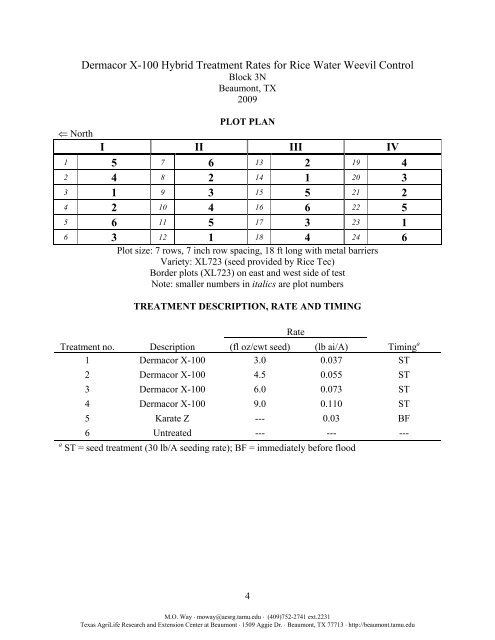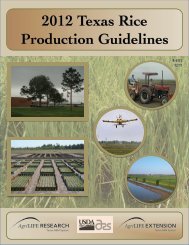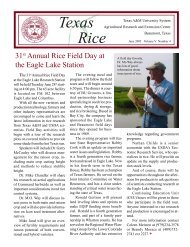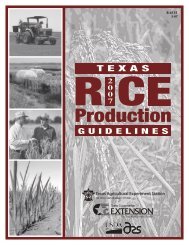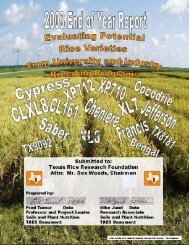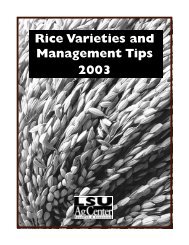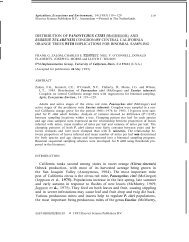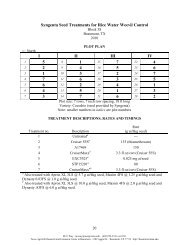Dermacor X-100 Hybrid Treatment Rates for Rice Water Weevil ...
Dermacor X-100 Hybrid Treatment Rates for Rice Water Weevil ...
Dermacor X-100 Hybrid Treatment Rates for Rice Water Weevil ...
You also want an ePaper? Increase the reach of your titles
YUMPU automatically turns print PDFs into web optimized ePapers that Google loves.
<strong>Dermacor</strong> X-<strong>100</strong> <strong>Hybrid</strong> <strong>Treatment</strong> <strong>Rates</strong> <strong>for</strong> <strong>Rice</strong> <strong>Water</strong> <strong>Weevil</strong> Control<br />
Block 3N<br />
Beaumont, TX<br />
2009<br />
PLOT PLAN<br />
⇐ North<br />
I II III IV<br />
1 5 7 6 13 2 19 4<br />
2 4 8 2 14 1 20 3<br />
3 1 9 3 15 5 21 2<br />
4 2 10 4 16 6 22 5<br />
5 6 11 5 17 3 23 1<br />
6 3 12 1 18 4 24 6<br />
Plot size: 7 rows, 7 inch row spacing, 18 ft long with metal barriers<br />
Variety: XL723 (seed provided by <strong>Rice</strong> Tec)<br />
Border plots (XL723) on east and west side of test<br />
Note: smaller numbers in italics are plot numbers<br />
TREATMENT DESCRIPTION, RATE AND TIMING<br />
<strong>Treatment</strong> no. Description (fl oz/cwt seed) (lb ai/A) Timing a<br />
1 <strong>Dermacor</strong> X-<strong>100</strong> 3.0 0.037 ST<br />
Rate<br />
2 <strong>Dermacor</strong> X-<strong>100</strong> 4.5 0.055 ST<br />
3 <strong>Dermacor</strong> X-<strong>100</strong> 6.0 0.073 ST<br />
4 <strong>Dermacor</strong> X-<strong>100</strong> 9.0 0.110 ST<br />
5 Karate Z --- 0.03 BF<br />
6 Untreated --- --- ---<br />
a ST = seed treatment (30 lb/A seeding rate); BF = immediately be<strong>for</strong>e flood<br />
4<br />
M.O. Way ⋅ moway@aesrg.tamu.edu ⋅ (409)752-2741 ext.2231<br />
Texas AgriLife Research and Extension Center at Beaumont ⋅ 1509 Aggie Dr. ⋅ Beaumont, TX 77713 ⋅ http://beaumont.tamu.edu
<strong>Dermacor</strong> X-<strong>100</strong> <strong>Hybrid</strong> <strong>Treatment</strong> <strong>Rates</strong> <strong>for</strong> <strong>Rice</strong> <strong>Water</strong> <strong>Weevil</strong> Control<br />
Agronomic and Cultural In<strong>for</strong>mation<br />
Experimental design: randomized complete block with 6 treatments and 4 replications<br />
Planting: Drill-planted XL723 @ 30 lb/A into League soil (pH 5.5, sand 3.2%, silt 32.4%,<br />
clay 64.4%, and organic matter 3.8 - 4.8%) on Apr 8<br />
Plot size = 7 rows, 7 inch row spacing, 18 ft long with metal barriers<br />
Emergence on Apr 23<br />
Irrigation: Flushed blocks (temporary flood <strong>for</strong> 48 hours, then drain) on Apr 8<br />
Note: Plots were flushed as needed from emergence to permanent flood<br />
Permanent flood (PF) on May 19<br />
Fertilization: All fertilizer (urea) was distributed by hand.<br />
120 lb N/A (1/3 of 170) on May 19 at PF<br />
60 lb N/A (1/3 of 170) on Jul 2 at 5% heading<br />
Total N = 180 lb/A<br />
Herbicide:<br />
Stam 80EDF @ 2.0 lb, Basagran @ 0.75 lb, Facet 75DF @ 0.25 lb and Ordram<br />
@ 2.0 lb (AI)/A and Agri-Dex @ 1.0 pt/A with a 2-person hand-held spray<br />
boom (13- 80015 nozzles, 50 mesh screens, 16 gpa final spray volume) on May<br />
8 <strong>for</strong> early season weed control<br />
<strong>Treatment</strong>s: <strong>Treatment</strong> 5 (Karate Z @ 0.03 lb AI/A) applied using a hand-held, CO 2<br />
pressurized, 3 nozzle (800067 tips with 50 mesh screens, 29 gpa) spray rig on<br />
May 19 (be<strong>for</strong>e PF)<br />
Sampling: Stand counts (3- 3 ft counts on rows 2, 4 and 6) on May 2<br />
<strong>Rice</strong> water weevil (RWW) cores (5 cores per plot, each core 4 inches diameter, 4<br />
inches deep, containing at least one rice plant) were collected on Jun 9 and Jun<br />
19. Core samples were stored in a cold-room, later washed through 40 mesh<br />
screen buckets and immature RWW counted.<br />
Note: Prior to analysis RWW counts trans<strong>for</strong>med using square root (x + 0.5)<br />
Whitehead (WH) counts in rows 1 – 3 and 5 – 7; collected WHs <strong>for</strong> dissection (5<br />
MRB; 0 SCB) on Jul 29<br />
Harvest: Harvested plots on Aug 12<br />
Size harvested plot = 7 rows, 7 inch row spacing, 18 ft long<br />
Yields converted to lb/A and adjusted to 12% moisture<br />
Data analysis: RWW and WH counts trans<strong>for</strong>med using x + 0.5 ; yields converted to 12%<br />
moisture; all data analyzed by ANOVA and means separated by LSD<br />
5<br />
M.O. Way ⋅ moway@aesrg.tamu.edu ⋅ (409)752-2741 ext.2231<br />
Texas AgriLife Research and Extension Center at Beaumont ⋅ 1509 Aggie Dr. ⋅ Beaumont, TX 77713 ⋅ http://beaumont.tamu.edu
<strong>Dermacor</strong> X-<strong>100</strong> <strong>Hybrid</strong> <strong>Treatment</strong> <strong>Rates</strong> <strong>for</strong> <strong>Rice</strong> <strong>Water</strong> <strong>Weevil</strong> Control<br />
Discussion<br />
Populations of RWW were high in untreated plots on both sample dates (Table 1). All<br />
<strong>Dermacor</strong> X-<strong>100</strong> treatments provided better RWW control than the Karate Z treatment on both<br />
sample dates. Among <strong>Dermacor</strong> X-<strong>100</strong> treatments, data show all tested rates effectively<br />
controlled RWW; however, the lowest rate (0.037 lb ai/A) gave a slight decrease in control<br />
compared to the higher rates. Dissection of rice plants revealed the predominant stalk borer<br />
species in the experiment was MRB. Although WH counts in plots without <strong>Dermacor</strong> X-<strong>100</strong><br />
seed treatment were low (typical of hybrid varieties), all <strong>Dermacor</strong> X-<strong>100</strong> seed treatments<br />
significantly reduced WHs compared to Karate Z plots. All <strong>Dermacor</strong> X-<strong>100</strong> seed treatments<br />
produced excellent yield responses (due to a combination of RWW and stalk borer control). The<br />
lowest rate of <strong>Dermacor</strong> X-<strong>100</strong> produced yields similar to the highest rate (1355 and 1034 lb/A<br />
yield advantage over the untreated in lowest and highest rates of <strong>Dermacor</strong> X-<strong>100</strong>, respectively).<br />
Results of this experiment suggest at low seeding rates of hybrid varieties excellent control of<br />
RWW and stalk borers can be achieved with lower than currently recommended rates of<br />
<strong>Dermacor</strong> X-<strong>100</strong>. In fact, <strong>Dermacor</strong> X-<strong>100</strong> at 0.037 lb ai/A, given a seeding rate of 30 lb/A,<br />
provided good control of both RWW and stalk borers, and produced an excellent yield response.<br />
The Karate Z treatment did not provide as good control of RWW compared to the <strong>Dermacor</strong> X-<br />
<strong>100</strong> treatments and did not control stalk borers. However, yield response to the Karate Z<br />
treatment was excellent.<br />
Table 1. Mean data <strong>for</strong> <strong>Dermacor</strong> X-<strong>100</strong> hybrid treatment rate study. Beaumont, TX. 2009.<br />
Rate<br />
No. RWW b /5 cores WHs b in 6 Yield<br />
<strong>Treatment</strong> (lb ai/A) Timing a Jun 9 Jun 19 rows (lb/A)<br />
<strong>Dermacor</strong> X-<strong>100</strong> 0.037 ST 4 bc 6 c 0 c 9780 a<br />
<strong>Dermacor</strong> X-<strong>100</strong> 0.055 ST 1 c 0 d 1 c 9732 a<br />
<strong>Dermacor</strong> X-<strong>100</strong> 0.073 ST 0 c 1 d 0 c 8874 b<br />
<strong>Dermacor</strong> X-<strong>100</strong> 0.110 ST 1 c 1 d 0 c 9459 a<br />
Karate Z 0.03 BF 8 b 15 b 4 a 9788 a<br />
Untreated --- --- 63 a 54 a 2 b 8425 b<br />
a ST = seed treatment (30 lb/A seeding rate); BF = immediately be<strong>for</strong>e flood<br />
b RWW = rice water weevil (larvae + pupae); WHs = whiteheads<br />
Means in a column followed by the same letter are not significantly different (P = 0.05, ANOVA<br />
and LSD).<br />
6<br />
M.O. Way ⋅ moway@aesrg.tamu.edu ⋅ (409)752-2741 ext.2231<br />
Texas AgriLife Research and Extension Center at Beaumont ⋅ 1509 Aggie Dr. ⋅ Beaumont, TX 77713 ⋅ http://beaumont.tamu.edu


